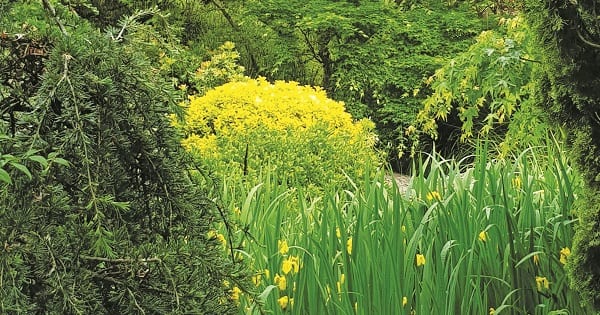Last weekend The Galston District Garden Club held the Open Garden Weekend, opening seven gardens for the public to ramble through as their leisure. The weather was very kind to us as we had three fine days apart from a shower first thing on Friday morning. All the money raised will go to charity; the garden owners nominate a charity of their choice as they have put a lot of work into presenting their gardens so beautifully.
The Club wishes to thank all those volunteers who “manned” the gates, who served the morning and afternoon teas, and sold the plants and books on display at “Elegans”. A big thank you to Bill Fleming who coordinated the event and thank you to the garden owners whose gardens we enjoyed.
The Iris were out to show off their colours in Garden 6 “Kettlzon”, named because one of the owners always asks “is the kettle on”. Several varieties of Iris plants exist, providing intricate and exquisite blooms in sunny areas of the landscape. Iris flowers begin blooming in late winter to early spring. A range of varieties provides extended colour in the flower be.
Iris care is minimal once the growing iris is established. Iris plant care consists mainly of dividing the iris plants to assure continued blooms. Iris plants are abundant multipliers but once the rhizomes of iris plants become crowded, the iris flowers may be limited, and the rhizomes need to be separated. Most commonly planted iris is the bearded iris.
Height of the bearded iris plants ranges from 7.5cm for the shortest of dwarf iris flowers to one metre for the tallest of the tall bearded iris. Iris flowers boom in shades of purple, blue, white and yellow and include many hybridized versions that are multi-coloured.
 Tips for Growing Iris: Plant rhizomes of the iris in a sunny location with well-draining, rich soil for optimum flowering. Leave room for growth between the rhizomes and do not bury the entire rhizome.
Tips for Growing Iris: Plant rhizomes of the iris in a sunny location with well-draining, rich soil for optimum flowering. Leave room for growth between the rhizomes and do not bury the entire rhizome.
Make sure roots are covered but allow the iris rhizome to remain partially above ground to avoid root rot. Once blooms fade, leave the foliage to yellow before removing it from the flowerbed. Plant so later blooming specimens cover the remaining foliage.
As with many spring blooms, the foliage is sending nutrients to the rhizome for next year’s flowers. This is one of the difficult parts of iris care, as many gardeners wish to remove foliage once flowering is done immediately.
Other iris plant care includes watering during dry spells, fertilization before flowers appear and deadheading of the spent blooms. However most clumps of iris provide flowers with no maintenance.
Iris is drought-tolerant and may be part of a xeric garden; keep in mind even drought-tolerant plants benefit from occasional watering. Xeric Garden: This type of landscaping uses as little water as possible. This has the advantages of making the xeric garden easier to plant and maintain, while also being more cost-efficient for the owner and less harmful for the environment.
The Galston District Garden club welcomes new members and visitors. We meet on the 2nd Wednesday of the month in the Galston Community Hall, at 7.30pm, 37 Arcadia Rd, Galston.
For further information visit our website: www.galstongardenclub.com.au or email: galstongardenclub@gmail.com







